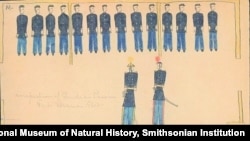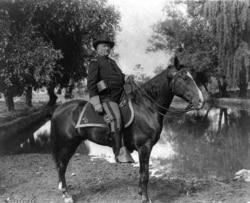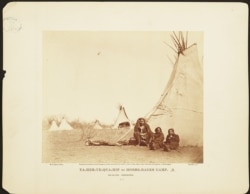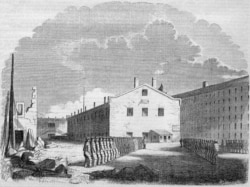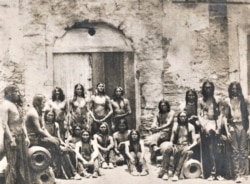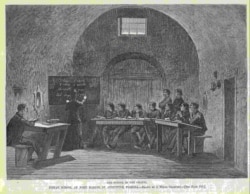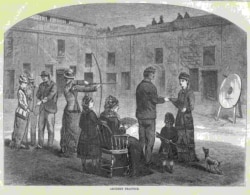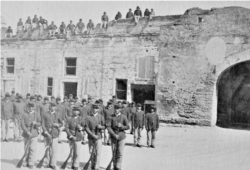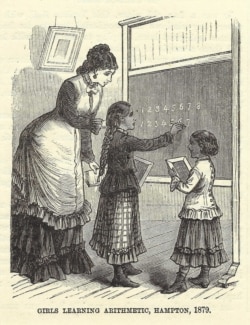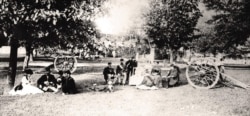NOTE: The discovery in June 2021 of 215 unmarked graves by Canada’s Tk’emlups te Secwepemc First Nation at the Kamloops Indian Residential School prompted the U.S. Interior Department to launch a federal investigation into hundreds of similar boarding schools in the United States.
Investigators are expected to submit a final report in April 2022, identifying the location of school facilities and possible student burial sites, as well as the names and tribal affiliations of those children who died there.
This is the first of a four-part series examining the history of the federal off-reservation boarding school system and its long-term impact on Native Americans and Alaska Natives.
It was in an abandoned Spanish fortress in Florida that a U.S. cavalry officer hatched an idea for how to solve the so-called “Indian question” — whether and how to assimilate Natives into American society.
Richard H. Pratt, a low-ranking cavalry officer, spent eight years on the Western frontier in charge of enlisted African American soldiers and Native American Army scouts, both of whom he believed deserved the citizenship and equal opportunities guaranteed by the Declaration of Independence and the U.S. Constitution.
But Pratt saw no value in African or Native cultures, as he made clear in an 1892 speech during a conference on social reform.
“Left in Africa, surrounded by their fellow-savages, our seven millions of industrious black fellow-citizens would still be savages,” he said. “They became English-speaking and civilized because [they were] forced into association with English-speaking and civilized people.”
By contrast, he continued, Indians had been forced onto remote reservations, far from the “civilizing” influence of English-speaking peoples. And it was in this speech that he cited a quote popular during the Indian wars: “The only good Indian is a dead one.”
“In a sense, I agree with the sentiment,” he said, “but only in this: that all the Indian there is in the race should be dead. Kill the Indian in him and save the man.”
The experiment
Stationed in 1875 at Fort Sill, Oklahoma, Pratt wanted “a change,” as he wrote in his memoir, “Battlefield and Classroom: Four Decades with the American Indian, 1867- 1904,” on which VOA has relied for much of this report.
Hearing that the Army was planning to send 72 Arapaho, Caddo, Cheyenne, Comanche and Kiowa war prisoners to Fort Marion in Florida, he wrote his commander, volunteering to escort them.
“Much can and should be done to reform these young men while under this banishment,” he noted.
It was a 1,000-mile journey by wagon, rail and steamboat that took nearly a month. Two prisoners died along the way — one by suicide, and the other shot while attempting escape.
Fort Marion, a grim stone citadel built by the Spanish in the 1600s, had been a U.S. Army outpost since the early 1800s. The prisoners arrived in chains and shackles and were forced to sleep on dirt floors inside dark vaulted chambers. After several prisoners became sick or died, Pratt decided to make some changes.
“The 19th century was a time of social reform in America,” said Sarah Hayes, professor of Philosophy and English at Seminole State College in Florida. “A large new social ideology was taking form.”
Hayes outlined in her 2015 doctoral dissertation “Penitential Education” that America had transitioned from an agricultural economy to an industrial one. The factory system brought thousands into the nation’s cities, leading to overcrowding and rising crime rates.
Until the early 19th century, education was only available to elite Americans, mostly boys. Now, public school systems, funded by the taxpayer, dotted the country, opening up education to all.
In 1870, members of the National Congress of Penitentiary and Reformatory Discipline met in Ohio to discuss ways in which prisons could focus on inmate reform by educating and incentivizing criminals. They concluded that prisoners should work to earn their keep, and good behavior should be rewarded with extra privileges and shortened sentences.
“What I found in my archival research -- and in looking at Richard Pratt's autobiography -- is that he was heavily influenced by both the prison and educational reform movements,” Hayes said.
The experiment at Fort Marion, she believes, mirrored what was going on in schools and prisons across the country.
Not long after they arrived in St. Augustine, Pratt unshackled the men and began work to “transform” them into soldiers, cutting their hair and issuing them military uniforms. He put them through all the rigors of military life, including daily inspections, drills and marches.
Local women set up makeshift classrooms inside the casemates, where they taught the prisoners to read, write and speak English. And, on Sundays, Pratt delivered religious sermons.
Eventually, he gave them freedoms unheard of in other prisons: he organized prisoners into a military company “with sergeants and corporals,” and armed them with rifles so that they could guard themselves. After some time, he allowed them to stroll armed into town.
“They were being watched constantly, not just by Pratt but by everyone in St. Augustine,” Hayes said. “Pratt knew they had nowhere to go.”
St. Augustine was a popular tourist designation, and Pratt encouraged prison visitors. The prisoners were soon polishing “seed beans,” large seed pods from island plants that washed ashore and selling them as souvenirs, along with the many pencil drawings they produced on army ledger books.
The men performed dances for spectators, and the Smithsonian Institute sent a sculptor to cast life masks of more than 60 prisoners, including the wife and 9-year-old daughter of Comanche Chief Black Horse, who had chosen to come with him to Florida.
Pratt’s memoir downplays the harshness of incarceration by emphasizing what Hayes describes as “endearing anecdotes” of camping, shark fishing and foot races, which he cited as evidence that hard work, discipline and Christianity could “civilize” the Indian.
But this was no summer camp, and discipline could be harsh. In 1876, after learning that four Kiowa inmates were planning an escape, Pratt rounded them up and ordered the fort surgeon to drug them via “hypodermic syringe.”
He then instructed guards to place the unconscious men into a cart and wheel them out of the fort, in full view of the other prisoners, who believed that the men were dead.
“Not one of these men will ever take up arms against the Government unless driven by the grossest bad treatment,” he later wrote to his commander.
From prison to school
The prisoners completed their sentences in spring 1878. While most looked forward to going home, about two dozen of the younger men asked to continue to study in the East.
Pratt arranged for a handful to live with benefactors in New York and Minnesota. He enrolled the remaining 17 at the Hampton Normal and Agricultural Institute -- now Hampton University -- a school in Virginia founded by Army General Samuel Armstrong to educate newly freed slaves.
The Interior Department had Pratt recruit another 50 students and put him in charge of Hampton’s Indian program.
But Pratt and General Armstrong clashed: while both men agreed that schooling was the answer to the “Indian question,” Armstrong wanted to separate Native students from Black students, which Pratt strongly opposed.
“Segregating any class or race of people apart from the rest of the people kills the progress of the segregated people or makes their growth very slow,” Pratt would state in 1902. “Association of races and classes is necessary to destroy racism and classism.”
Pratt left Hampton and spent much of 1879 lobbying for a school of his own. He asked the Interior and War department secretaries to turn over abandoned Army barracks in Carlisle, Pennsylvania, for that purpose.
Washington, still grappling with the “Indian problem,” did not need much convincing. In September, Pratt made two more trips West, bringing back more than 135 youths -- boys and girls -- from several tribes.
And on November 1, 1879, still waiting for shipments of food, clothing and supplies, the Carlisle Indian Industrial School, the government’s first off-reservation boarding school, formally opened.
In the next article in this series, VOA will examine the Carlisle School's Outing Program by which Pratt placed students in white homes and farms, to learn farming and domestic skills and be exposed to "good, wholesome, civilized life."




